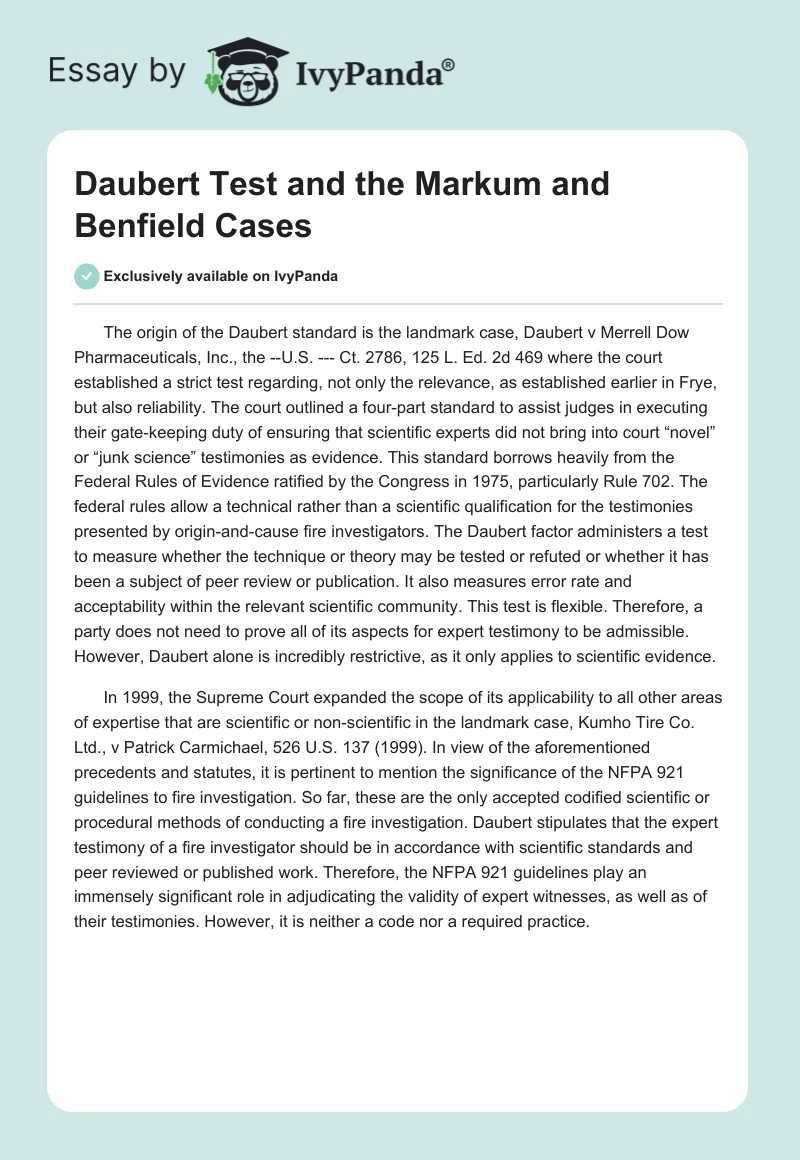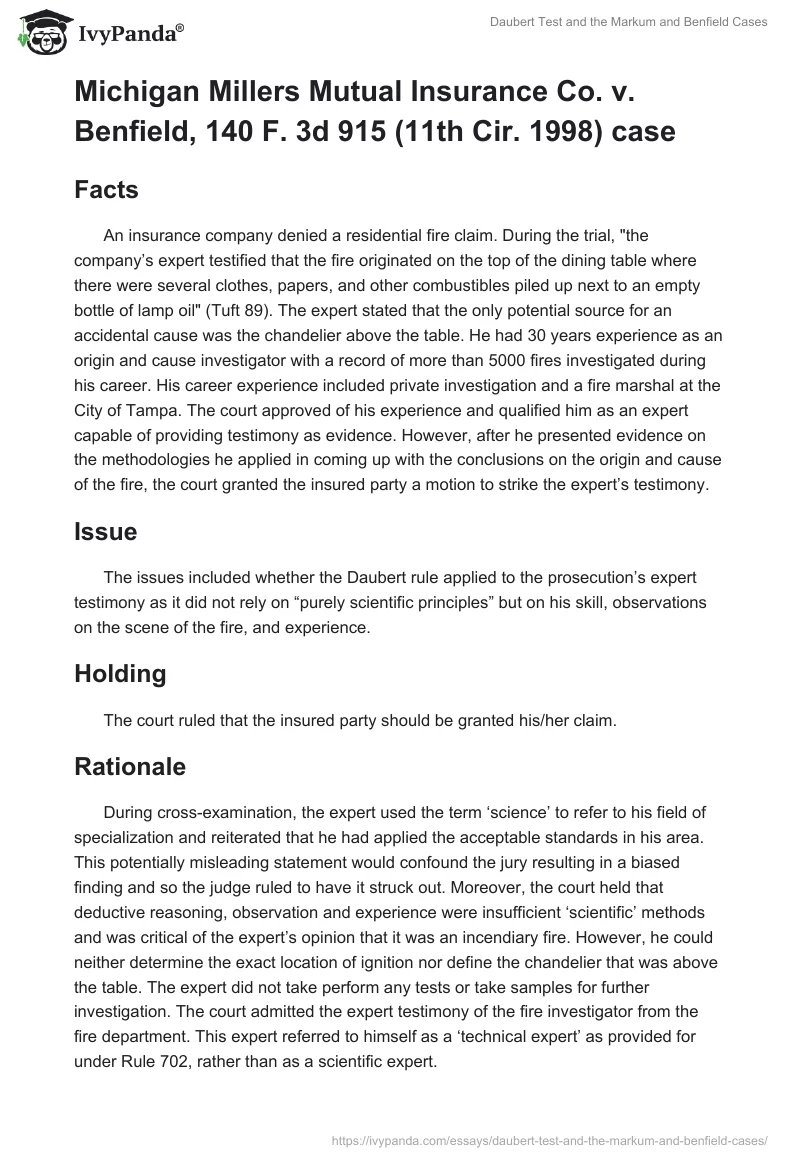The origin of the Daubert standard is the landmark case, Daubert v Merrell Dow Pharmaceuticals, Inc., the –U.S. — Ct. 2786, 125 L. Ed. 2d 469 where the court established a strict test regarding, not only the relevance, as established earlier in Frye, but also reliability. The court outlined a four-part standard to assist judges in executing their gate-keeping duty of ensuring that scientific experts did not bring into court “novel” or “junk science” testimonies as evidence. This standard borrows heavily from the Federal Rules of Evidence ratified by the Congress in 1975, particularly Rule 702. The federal rules allow a technical rather than a scientific qualification for the testimonies presented by origin-and-cause fire investigators. The Daubert factor administers a test to measure whether the technique or theory may be tested or refuted or whether it has been a subject of peer review or publication. It also measures error rate and acceptability within the relevant scientific community. This test is flexible. Therefore, a party does not need to prove all of its aspects for expert testimony to be admissible. However, Daubert alone is incredibly restrictive, as it only applies to scientific evidence.
In 1999, the Supreme Court expanded the scope of its applicability to all other areas of expertise that are scientific or non-scientific in the landmark case, Kumho Tire Co. Ltd., v Patrick Carmichael, 526 U.S. 137 (1999). In view of the aforementioned precedents and statutes, it is pertinent to mention the significance of the NFPA 921 guidelines to fire investigation. So far, these are the only accepted codified scientific or procedural methods of conducting a fire investigation. Daubert stipulates that the expert testimony of a fire investigator should be in accordance with scientific standards and peer reviewed or published work. Therefore, the NFPA 921 guidelines play an immensely significant role in adjudicating the validity of expert witnesses, as well as of their testimonies. However, it is neither a code nor a required practice.
Michigan Millers Mutual Insurance Co. v. Benfield, 140 F. 3d 915 (11th Cir. 1998) case
Facts
An insurance company denied a residential fire claim. During the trial, “the company’s expert testified that the fire originated on the top of the dining table where there were several clothes, papers, and other combustibles piled up next to an empty bottle of lamp oil” (Tuft 89). The expert stated that the only potential source for an accidental cause was the chandelier above the table. He had 30 years experience as an origin and cause investigator with a record of more than 5000 fires investigated during his career. His career experience included private investigation and a fire marshal at the City of Tampa. The court approved of his experience and qualified him as an expert capable of providing testimony as evidence. However, after he presented evidence on the methodologies he applied in coming up with the conclusions on the origin and cause of the fire, the court granted the insured party a motion to strike the expert’s testimony.
Issue
The issues included whether the Daubert rule applied to the prosecution’s expert testimony as it did not rely on “purely scientific principles” but on his skill, observations on the scene of the fire, and experience.
Holding
The court ruled that the insured party should be granted his/her claim.
Rationale
During cross-examination, the expert used the term ‘science’ to refer to his field of specialization and reiterated that he had applied the acceptable standards in his area. This potentially misleading statement would confound the jury resulting in a biased finding and so the judge ruled to have it struck out. Moreover, the court held that deductive reasoning, observation and experience were insufficient ‘scientific’ methods and was critical of the expert’s opinion that it was an incendiary fire. However, he could neither determine the exact location of ignition nor define the chandelier that was above the table. The expert did not take perform any tests or take samples for further investigation. The court admitted the expert testimony of the fire investigator from the fire department. This expert referred to himself as a ‘technical expert’ as provided for under Rule 702, rather than as a scientific expert.
Effects
This case put fire investigators on the spot concerning whether to refer to themselves as scientific experts or technical experts during trial (Mitchells 76). It also exerted pressure on them to align their procedure by the NFPA 921, which serves as the professional standard for fire investigators in all states.
United States v. Markum 4 F. 3d 891, 895-96 (10th Cir. 1993) case
Facts
This was an appeal case where the appellant Judy Louise Brown Markum was challenging her conviction. She was guilty of conspiracy to commit arson contrary to 18 U.S.C. Sec. 371 and mail fraud in violation of 18 U.S.C. Sec. 2.
Issues
She purported that the evidence of guilt adduced by the prosecution against her was insufficient that the district court made a mistake in admitting expert opinion evidence. In addition, the district court had improperly enhanced her sentence under the U.S Sentencing Commission, Sentencing Guidelines. However, this paper will only apply itself to the issue of expert evidence due to the limited scope of the topic in question.
Holding
The appeal failed on all grounds. As a result, the court upheld her sentence.
Rationale
The appellant claimed that the court had abused its discretion in allowing Chief Pearson’s witness testimony, United States v Barbee, 968 F. 2d 1026, 1031 (10th Cir. 1992) and Post Office v Portec, Inc., 913 F. 2d 802, 806 (10th Cir. 1990). The rule, as established under Rule 702, which incorporates the Daubert factor states:
“If scientific, technical, or other specialized knowledge will assist the trier of fact to understand the evidence or to determine a fact in issue, a witness qualified as an expert by knowledge, skill, experience, training, or education may testify thereto in the form of an opinion or otherwise” (Bernstein 2).
Markum’s contention was that the expert had testified that the second fire was a result of arson (Tuft 89). There was sufficient evidence to support this testimony and even Markum admitted that it was arson. On the matter of whether arson was a specialized area, there was the statement that the fact that fire departments had specialized arson investigation units were sufficient evidence of specialization. That the second fire was incendiary was a relevant factual question. Since Markum did not object to the expert’s qualification, it meant that this fact could only be reviewed as a plain error.
Effects
This case is an illustration of the court rejecting the proposition that all the factors of the Daubert standard need to prove before expert evidence can be admissible. Consequently, courts have a wider discretion in determining admissibility of evidence and parties to a trial have a greater burden of proof.
How the court cases went together
In both Markum and Benfield, the courts admitted evidence that did not necessarily satisfy the consolidated four-part Daubert test (Bernstein 2). However, the courts were keen on how they applied the test. For instance, in Benfield, a simple use of the ‘phrase’ disqualified exceptionally reliable evidence.
Works Cited
Bernstein, David. Disinterested in Daubert: State Courts Lag Behind in Opposing Junk Science. Legal Opinion Letter: Washington Legal Foundation 12.14(2002): 2.
Mitchells, Daisy. Evidentiary Burden of Proof in Arson Cases. Washington, DC: Oxford University Press, 2004. Print.
Tuft, Ezra. Rules of Edivence: The Daubert Standard. Oklahoma: Springler, 2006. Print.


